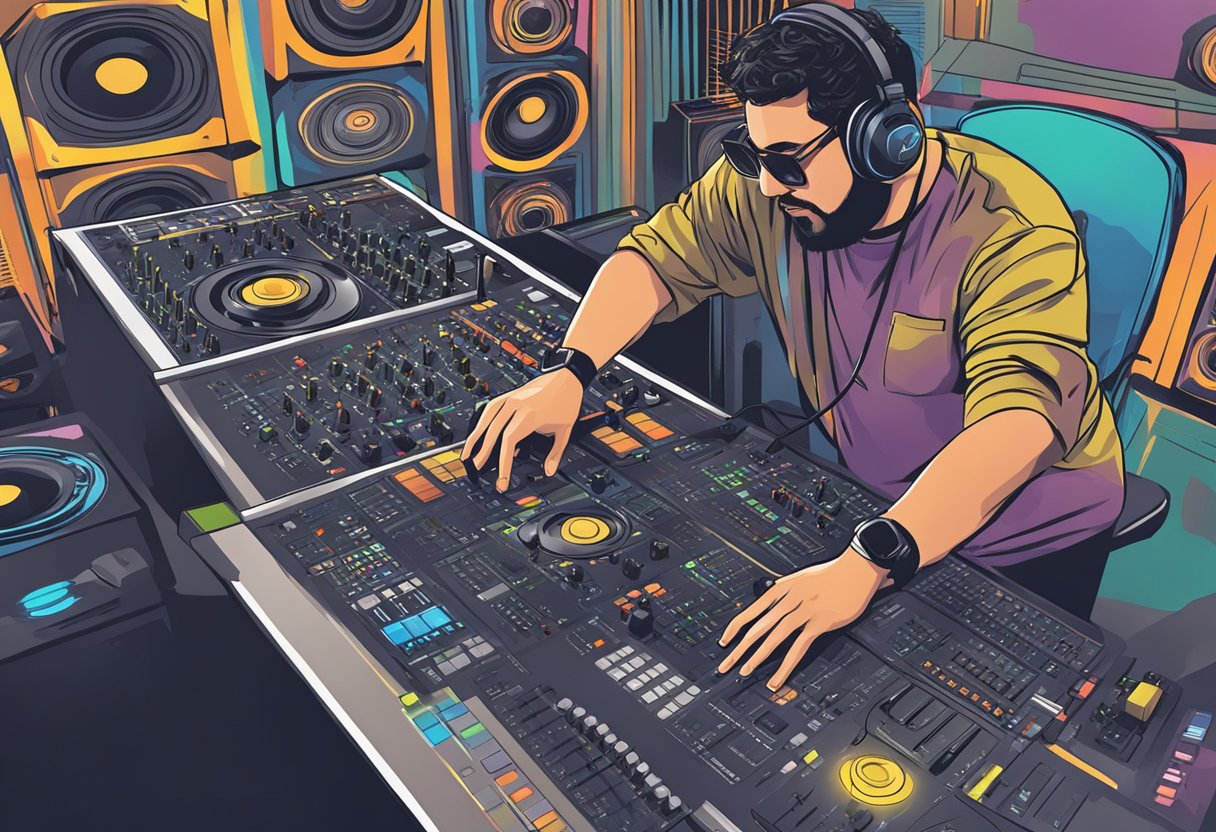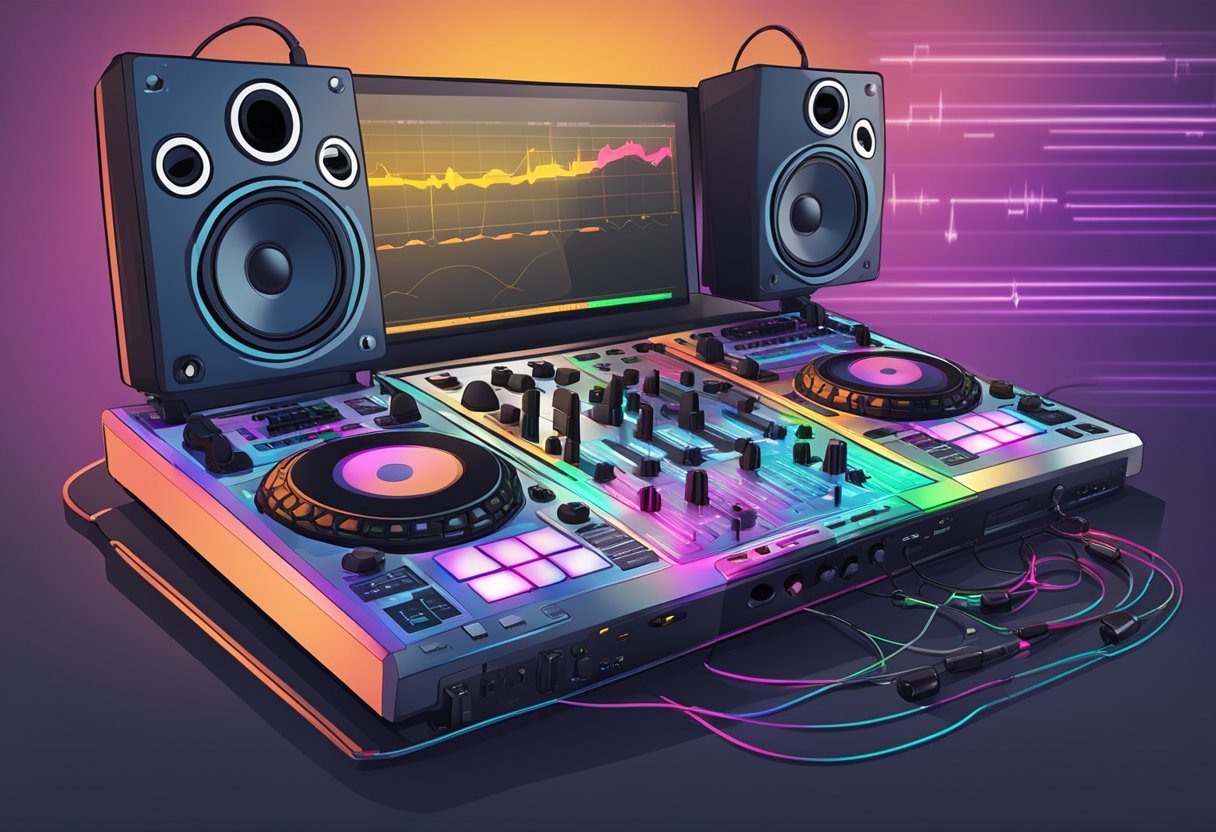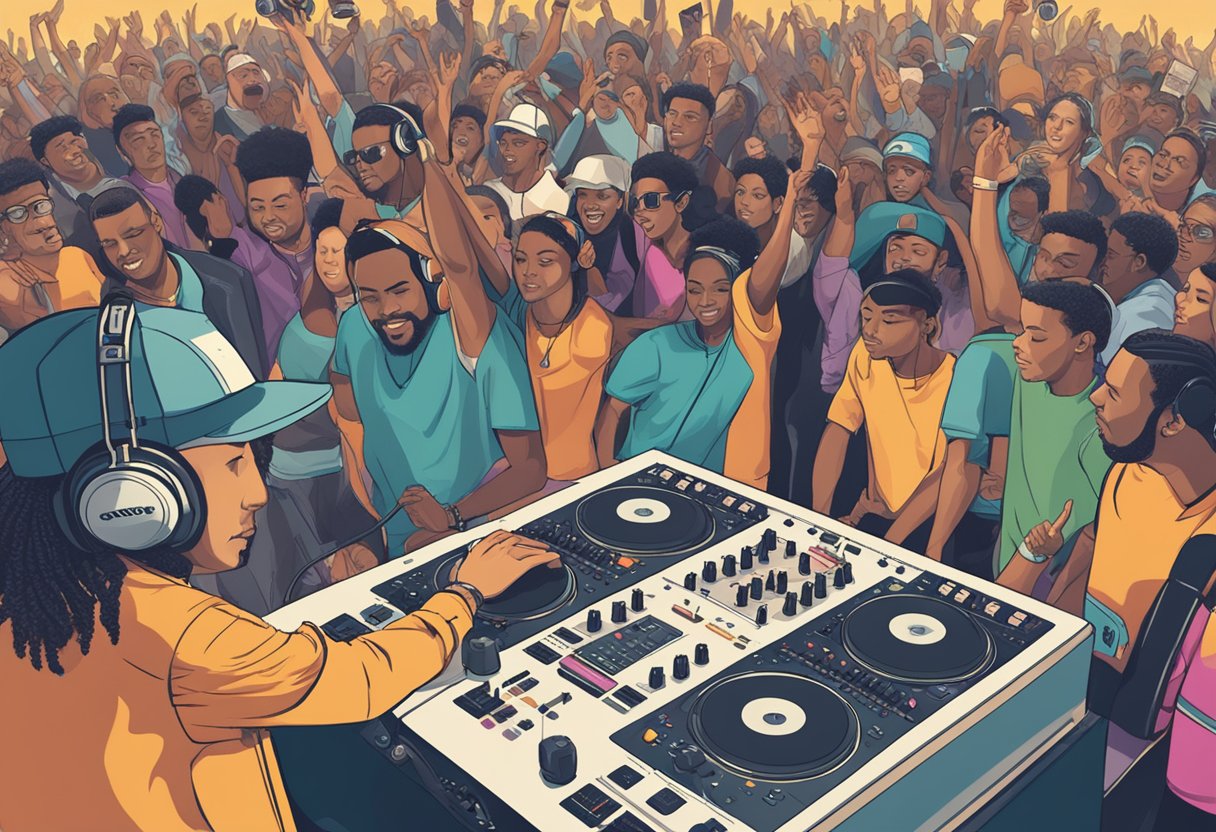Timing is a fundamental aspect of DJing that distinguishes the average DJs from the skilled ones. Knowing when to mix in a new song is a critical skill because doing so at the right moment can maintain the energy on the dance floor and create a seamless listening experience. It requires a deep understanding of music structure, an ability to read the crowd, and the technical proficiency to execute the mix smoothly. Each track typically consists of various elements such as intros, outros, and phrases, and the mix-in point often coincides with the end of a phrase or section in the outgoing track.

Crucial to mastering the art form of DJing is the development of effective mixing techniques and skills. This encompasses beatmatching, the use of EQs, and knowledge of various transition types, which could range from a simple fade to more complex effects-driven mixes. The right timing for mixing in a song depends on factors such as the genre, the vibe of the current track, and the DJ’s intention for the energy flow. A successful mix often goes unnoticed by the crowd, as it should feel like a natural progression from one song to the next.
Key Takeaways
- Understanding when and how to mix songs is essential for a DJ to keep the flow and energy of a set.
- Mixing techniques vary and should be mastered for smooth transitions between tracks.
- Reading the crowd’s reaction plays a significant role in the timing and selection of the next song to mix.
Understanding the Basics of DJ Mixing
Before diving into the intricacies of DJ mixing, it’s crucial to have a solid grasp of music theory, understand the equipment required, and become proficient with DJ software. Each element plays a pivotal role in creating seamless transitions between tracks.
Music Theory and Song Structure
In my experience, music theory and song structure are the scaffolding for successful DJ mixing. I prioritize learning the basics of beats, bars, and phrases, which are fundamental in lining up two tracks harmonically and rhythmically. For example, knowing that most dance music follows a 4/4 time signature with patterns repeating every 16 beats is a key skill. I also pay close attention to the composition of tracks, recognizing intros, outros, breaks, and drops, as these are crucial for understanding when to mix in songs as a DJ. Aligning these song elements ensures a smooth blend between tracks.
Equipment Essentials
To execute a mix, the equipment is as important as the skills. My toolkit includes a DJ controller or CDJs and a DJ mixer, which are the heart of my setup. I’m partial to a controller that can integrate with software such as Serato or Virtual DJ, as it allows me to manage my music effectively. High-quality headphones are indispensable for cueing up tracks and monitoring my mix in real-time. For enthusiasts of vinyl, turntables provide a tactile experience that digital systems try to emulate. It’s essential to choose equipment that resonates with my style and workflow.
Familiarizing with DJ Software
Mastering DJ software is like learning to navigate a new city—once I know my way around, I can explore freely. Familiarity with platforms like Mixxx, djay Pro, or Virtual DJ is critical. These software solutions offer a range of tools, from waveform visualization to beat-syncing features, that aid in constructing a set. I make sure to familiarize myself with the software’s interface, learning hot cues, loop functionality, and effects to add depth and creativity to my mixes. It’s important to remember that flexibility and comfort with my chosen software enhance my ability to deliver a compelling performance.
Preparing Your DJ Set
When I prepare for a DJ set, my focus is on crafting a lineup of tracks that seamlessly blends genres and energies, while creatively utilizing BPM and cue points.
Selecting Tracks and Genres
My approach to selecting tracks revolves around creating a versatile set list that spans multiple genres, such as pop, hip-hop, house music, EDM, and drum and bass. I make sure each track aligns with the event’s theme and resonates with the crowd. It’s essential to consider the flow between genres and maintain a coherent energy level across the set.
Analyzing Beats per Minute (BPM) and Energy
I closely analyze each track’s beats per minute (BPM) as it serves as the backbone for my set. I create a BPM range that matches the desired energy, whether building momentum with slower songs or sustaining high energy with faster beats. Categorizing tracks by BPM in my library allows for efficient transitions.
- Low Energy: 70-90 BPM
- Mid Energy: 91-110 BPM
- High Energy: 111-130 BPM
- Peak Energy: 130+ BPM
Energy Flow: Start Mid → Build High → Peak → Cool Low
Cue Points and Counting Bars
Setting cue points is critical for my execution. I analyze each track, marking specific moments for mixing in and out. This involves understanding the structure of music and counting bars — a standard phrase in most electronic tracks is eight bars. Having cue points at the ready ensures I can mix tracks live and adjust on the fly to match the crowd’s vibe.
Mixing Techniques and Skills
In my experience, success in DJ mixing hinges on mastering a variety of techniques that ensure a seamless and engaging set. From beat matching to EQing, each skill enhances the overall mix, enabling me to take the audience on a musical journey.
Beat Matching and Sync Techniques
Beat matching is foundational for a DJ – it’s the practice of aligning the tempo of two tracks so they play in unison. This can be done by ear or with the help of a sync button, which automatically matches the beats of the songs. For me, understanding the structure of a track is key. I listen for phrases and ensure that I mix in a new song at the moment that makes musical sense, such as during a break or at the end of a phrase. If I use a sync button, I sometimes use the quantize function to keep the timing of my cues sharp.
Harmonic Mixing and Key Detection
Harmonic mixing is where I mix tracks that are in compatible keys, creating a smooth transition that’s pleasing to the ear. I use key detection software to identify the key of my tracks. Understanding musical theory and the Circle of Fifths helps me decide which tracks will blend well together harmonically. This skill elevates my set by maintaining a consistent mood and energy, avoiding discordant transitions that can jar the listener.
EQing and Using the Crossfader
EQing is essential; it’s about balancing the lows, mids, and highs. When I’m preparing to bring in a new track, I may cut the bass on the upcoming song to avoid clashing with the playing track. As I transition, I gradually swap the frequencies so there’s never a battle between kicks or basslines. The crossfader is instrumental for me to deftly move from one track to another, often I might use it subtly to add a bit of texture by creating a quick blend or a sharp cut, depending on the vibe I’m aiming for. It’s a powerful tool and, when used effectively, contributes significantly to the dynamics of my set.
By honing these skills, I ensure that my DJ mixing is not only technically sound but also emotionally captivating.
Timing Your Mix
In DJing, timing is not just a skill—it’s an art form that distinguishes good mixes from great ones. It’s crucial to have precision with your transitions and to understand how different segments in a song can create a seamless and dynamic set.
Identifying Phrases and Verses
I always begin my mix by getting familiar with the structure of the tracks I want to blend. A standard track is often composed of phrases, typically consisting of 4 to 8 bars, and verses. It’s my job to identify these and use them as a roadmap for my mix. I listen for the end of a phrase, which often signals a natural break point.
Transitioning at the Right Moment
Timing the transition is something that can make or break a mix. My aim is to match the tempo of both tracks and execute the switch at the end of a phrase or just before the drop. This ensures that the energy remains high and the audience stays engaged. It’s about being precise; in most cases, I look for the last beat of the bar to initiate my transition.
Building Momentum Through Breakdown and Build Up
The dynamics of a song’s breakdown and build up sections are my best friends when I’m aiming to take the crowd on a journey. I leverage the anticipatory nature of a build-up followed by the resolution of a breakdown to enhance my mix’s momentum. It’s an exhilarating feeling, dropping in a new track at the peak moment to maintain or amplify the audience’s energy.
Advanced Techniques
In my journey as a DJ, I’ve learned that mastering advanced techniques is crucial for standing out in a crowded field. Here, I’ll share some of the sophisticated skills and methods that have elevated my performances.
Live Remixing and Looping
One of my go-to approaches for enriching the auditory experience is live remixing and looping. By manipulating the size of a loop from extended sequences down to beat fractions, I generate dynamic builds and drops. For instance, I may start with a 16-beat loop, then progressively halve it to increase tension, before releasing into the full track.
Effect Utilization and Sound Manipulation
Another layer of my sets involves effect utilization and sound manipulation. Utilizing tools like EQs, filters, and reverb, I shape and contour the soundscape. When I apply a high-pass filter to gradually introduce a track, it creates an almost imperceptible blend that captures the crowd.
Creating a Signature Style
Finally, I infuse my mixes with a signature style that reflects my personal brand. Through a distinctive selection of tracks and unique transition techniques, such as seamless fade mixing, my sets become an authentic representation of my artistic identity. Curating a playlist that tells a story, aligned with my aesthetic, has been a powerful way to connect with my audience.
Performance and Crowd Reading
In my experience, a successful DJ performance hinges on the crucial skill of crowd reading. I’ve found it to be the backbone that informs song selection, the timing of mixes, and the overall energy flow of a set.
Engaging Your Audience
I always start by observing the crowd’s immediate reaction to tracks. An attentive DJ can sense the audience’s preferences within the first few songs. By noting which beats get their heads nodding or their feet moving, I tailor my track list in real-time. For example, if I notice an uptick in energy with ’80s hits, I’ll incorporate more from that era to maintain engagement.
Adapting to Live Feedback
I take note of live feedback—be it cheers, song requests, or dancefloor activity. It’s a real-time barometer of performance. Let’s say a track isn’t resonating; I’ll mix in a different genre or a well-known hit to recapture attention. A technique covered in “How DJs read the crowd” supports this, highlighting the importance of adapting to the crowd’s mood to prevent energy dips.
Energy Management
Managing the energy levels of a venue is a dynamic process. I build up the energy gradually, avoiding sudden shifts that might jar the audience. Resourceful tips found in guides like “The DJ’s Guide to Reading the Room: Understanding Your Audience” suggest transitioning from genre to genre seamlessly. This ensures the crowd stays with me on a coherent musical journey. Balancing high-intensity tracks with mellow intermissions helps to sustain the crowd’s stamina throughout the night.
Practical Considerations for DJing

When DJing, understanding sound levels, the purpose of headphone cueing, and when to use automation are crucial for seamless transitions and a balanced mix. Below are the strategies I use to manage these aspects effectively.
Sound Levels and Gain Structure
I begin by setting the correct gain levels for each track to maintain an even sound across my set. Proper gain staging ensures that the lows (bass), mids (midrange), and highs (treble) are well balanced, and the overall sound isn’t distorted at high volumes. I ensure that the gain knobs are adjusted so that each track hits the same level on the mixer’s VU meters, usually just below the red zone to prevent clipping. The master volume should be set to a level that is loud enough for the room but leaves some headroom for track adjustments.
Headphone Cueing
Next, I focus on headphone cueing, which allows me to hear tracks through my headphones before the audience does. This is essential for beatmatching and preparing the next track. Cueing lets me isolate whether the track’s beat matches the outgoing track by listening to the proposed mix in my headphones. It also lets me adjust the frequencies—tweaking the lows, mids, and highs—to ensure a smooth blend between songs.
Using Automation and Automix
There are times when I utilize automation tools as part of my performance, such as sync for beatmatching or preset cue points for critical mix points. Automix can be a handy feature for moments that require my attention elsewhere, like during event announcements or when interacting with the audience. It allows for automated mixing of tracks, which can maintain the flow of music without abrupt changes. However, I always monitor these automated mixes closely and adjust as necessary to ensure the dynamism of my set remains intact.
Continuous Learning and Improvement

To stay relevant and effective as a DJ, I recognize the necessity of continuous learning and improvement. The rapidly evolving music scene and the expansive set of skills required demand that I am always building on my expertise.
Keeping Up with Music Trends
I make it a priority to stay abreast of the latest music trends. This means regularly scanning top charts, exploring new genres, and embedding emerging sounds into my sets. By actively listening to new releases and monitoring music trend insights, I ensure that my performances remain fresh and exciting for the audience.
Expanding Your Skill Set
As a beginner DJ, I focus on mastering the foundational skills but, as I progress, expanding my skill set becomes vital. This includes learning advanced mixing techniques, experimenting with effects, and perfecting transitions. Through practice and online tutorials, I develop these competencies further, pushing the boundaries of what I can achieve on the decks.
Leveraging Educational Resources
I continually leverage a variety of educational resources to enhance my DJing proficiency. This involves watching YouTube videos to gather DJ tips, participating in workshops, and using online platforms that offer in-depth courses. These educational tools provide me with valuable insights and practical knowledge that I can apply directly to my performances.
Frequently Asked Questions

In my experience, these are the most common inquiries beginners have regarding DJ mixing techniques and best practices.
What are some tips for mastering smooth song transitions during a DJ set?
When mixing tracks, I find it crucial to ensure the songs’ beats are synchronized. A seamless transition often hinges on manipulating the EQ to balance the bass, mid, and treble, allowing one song to flow into another without abrupt changes in sound. DJ Mixing Techniques For Beginners outlines the use of gain controls as an effective way to manage volume during these transitions.
Can you explain different types of DJ mixing techniques?
Certainly, each DJ style has its own set of techniques. For instance, beatmatching involves aligning the tempos of two tracks to ensure a rhythmic blend. There’s also EQ mixing, which involves tweaking frequency levels for smooth sonic transitions, and effects mixing that utilizes effects processors to add creativity to mixes.
How can DJs identify the perfect moment to mix in the next track?
The ideal time to introduce a new track is typically at the end of a musical phrase. It requires careful listening and an understanding of song structure to recognize these opportune moments. As Starter DJ suggests, the end of a phrase is often the right moment to mix in a new song.
In the context of electronic music, what role does song structure play in a DJ’s set?
Understanding song structure is fundamental in electronic music because it informs me when a track is about to change phases. This awareness aids in achieving timing precision when transitioning between tracks. Recognizing the buildups, breakdowns, and drops in electronic music can drastically improve the flow of a DJ set.
What is the importance of mixing in key, and how often do professional DJs practice this?
Mixing in key contributes to a harmonically pleasing transition, which can greatly enhance the listening experience. Professional DJs consistently practice harmonic mixing to ensure their sets sound coherent and musically engaging.
What are the characteristics of effective hip hop transitions for DJs?
Effective hip hop transitions are characterized by precise scratch techniques and well-timed drops that complement the rhythmic patterns of the genre. Hip hop DJs often employ the use of acapellas and instrumentals for dynamic live remixing and creating impactful song transitions.
